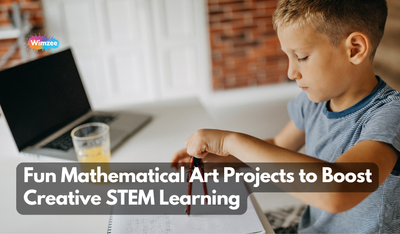Math meets art in these fun projects! Create geometric patterns, string art, and symmetry snowflakes. Explore Fibonacci spirals, mandalas, pixel art, and tessellation tiling. Discover math in nature and design your own math board games. Perfect for kids, parents, and creative pros. Dive into these activities to boost creative STEM learning and make math exciting!
Math and art might seem like they're from different planets. But guess what? They can team up to make learning super fun! These projects are perfect for kids, parents, and all you creative pros out there. So, let's dive into some cool activities that blend numbers with creativity.
Geometric Patterns with a Twist
Grab some graph paper and colored pencils. Draw shapes like triangles, squares, and hexagons. Now, color them in different patterns. See how many designs you can come up with. It's like making your own art puzzle! You might start with simple designs and then experiment with more complex arrangements. The key is to let your imagination run wild. It's not just about coloring inside the lines; it's about creating a pattern that speaks to you.
Tips for Creating Geometric Patterns
- Start Simple: Begin with basic shapes and then layer them.
- Use Colors Wisely: Contrast colors to make certain shapes pop.
- Experiment with Symmetry: Try symmetrical designs for a balanced look.
String Art Geometry
Ever seen those cool string art designs? They’re not just pretty—they're math-tastic! Use a board, some nails, and colorful string. Map out points for a shape (like a circle or a star) and connect the dots with string. Boom! You've just made a math masterpiece. String art is a fantastic way to explore geometric concepts like points, lines, and angles.
Steps to Create String Art
- Choose Your Shape: Start with a simple shape like a circle or a triangle.
- Hammer the Nails: Space them evenly around the perimeter.
- Connect the Dots: Use string to connect the nails in a pattern.
Symmetry Snowflakes
Fold a piece of paper and cut out shapes. Open it up to reveal a symmetrical snowflake! It's a hands-on way to understand symmetry. Plus, you get to make your own winter wonderland, no snow required. This activity is not only fun but also an excellent way to explore the concept of reflection symmetry.
Creating Symmetrical Snowflakes
- Fold Carefully: The more folds, the more intricate the snowflake.
- Cut with Precision: Small cuts can create detailed patterns.
- Unfold Gently: Reveal your unique design with care.
Creative STEM Toys
There are loads of toys that mix math and art. Think Lego sets that let you build geometric structures or magnetic tiles for making colorful 3D shapes. These toys make learning feel like playtime. They encourage spatial awareness and problem-solving skills, which are crucial in STEM learning.
Popular STEM Toys
- Lego Kits: Great for building complex structures.
- Magnetic Tiles: Perfect for creating 3D shapes.
- Pattern Blocks: Useful for exploring symmetry and tessellation.
Fibonacci Art
The Fibonacci sequence isn't just a fancy math term. It’s a secret code in nature! Draw spirals that follow this sequence. You'll see these spirals in sunflowers, shells, and even pinecones. Nature’s pretty smart, huh? This project helps visualize how math is intertwined with the natural world.
Drawing Fibonacci Spirals
- Start with a Grid: Use graph paper for accuracy.
- Plot the Sequence: Mark the Fibonacci numbers on your grid.
- Draw the Spiral: Connect the points smoothly.
Math Mandalas
Create mandalas using rulers and compasses. These intricate designs are super relaxing to draw. Plus, they’re packed with math principles like symmetry and geometry. A zen way to learn! Mandalas are a great way to practice precision and focus, two skills that are beneficial in both math and art.
Steps to Create a Mandala
- Draw a Circle: Use a compass for a perfect circle.
- Divide Evenly: Use a protractor to divide the circle into equal sections.
- Design with Patterns: Fill each section with repeating patterns.
Pixel Art with Math
Use grid paper to create pixel art. Each square can be a different color to form a bigger picture. It's like bringing video game art into the real world. And hey, it's all about counting and planning. Pixel art is a fun way to engage with concepts like area and perimeter.
Making Pixel Art
- Plan Your Design: Sketch your idea on paper first.
- Count Your Squares: Ensure each color section is the right size.
- Fill with Color: Use markers or colored pencils to bring your design to life.
Tessellation Tiling
Ever seen those mesmerizing tiled patterns? They’re called tessellations. Try making your own with paper shapes that fit perfectly together. It's a puzzle, art project, and math lesson all in one. Tessellations are a wonderful way to explore geometry and spatial reasoning.
Creating Tessellations
- Choose a Shape: Start with a simple shape like a square or triangle.
- Repeat the Pattern: Ensure the shapes fit together without gaps.
- Add Color: Use different colors to highlight the pattern.
Math in Nature Walk
Take a walk outside and look for math in nature. Count the petals on flowers, spot symmetrical leaves, or find geometric shapes in rocks. It’s like a math scavenger hunt! This activity encourages observation and curiosity, two essential components of scientific inquiry.
Things to Look For
- Patterns in Leaves: Symmetry and fractals.
- Shapes in Rocks: Look for geometric forms.
- Counting in Flowers: Count petals and see if they match Fibonacci numbers.
DIY Math Board Games
Create your own board game with math challenges. Use dice, cards, and a board you design yourself. It's a fun way to practice math skills while getting creative with game design. Board games are a fantastic way to combine logic, strategy, and creativity.
Designing a Math Board Game
- Decide on Rules: What math skills will your game focus on?
- Design the Board: Create a path with different challenges.
- Make it Fun: Add elements of chance and strategy.
These projects aren't just about doing math—they're about seeing math in a new, fun light. So grab your supplies and get creative. You might just find that math is more than numbers—it's a whole world of possibilities.




